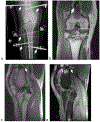Safety and image quality of MR-conditional external fixators for 1.5 Tesla extremity MR
- PMID: 33449260
- PMCID: PMC8122074
- DOI: 10.1007/s10140-020-01880-4
Safety and image quality of MR-conditional external fixators for 1.5 Tesla extremity MR
Erratum in
-
Correction to: Safety and image quality of MR-conditional external fixators for 1.5 Tesla extremity MR.Emerg Radiol. 2021 Jun;28(3):687. doi: 10.1007/s10140-021-01906-5. Emerg Radiol. 2021. PMID: 33502647 Free PMC article. No abstract available.
Abstract
Purpose: To evaluate the safety and image quality of extremity MR examinations performed with two MR conditional external fixators located in the MR bore.
Materials and methods: Single-center retrospective study of a prospectively maintained imaging dataset that evaluated MR examinations of extremities in patients managed with external fixations instrumentation and imaged on a single 1.5T MR scanner. The fixation device was one of two MR-conditional instrumentation systems: DuPuy Synthes (aluminum, stainless steel, carbonium and Kevlar) or Dolphix temporary fixation system (PEEK-CA30). Safety events were recorded by the performing MR radiologic technologist. A study musculoskeletal radiologist assessed all sequences to evaluate for image quality, signal- and contrast-to-noise ratios (SNR/CNR), and injury patterns/findings.
Results: In the 13 men and 9 women with a mean age of 42 years (range 18 to 72 years), most patients (19/22 patients; 86%) were involved with trauma resulting in extremity injury requiring external fixation. MR examinations included 19 knee, 2 ankle, and 1 elbow examinations. There were no adverse safety events, heating that caused patient discomfort, fixation dislodgement/perturbment, or early termination of MR examinations. All examinations were of diagnostic quality. Fat-suppressed proton density sequences had significantly higher SNR and CNR compared to STIR (p = 0.01 to 0.04). The lower SNR of STIR and increased quality of fat-suppressed proton density during the study period led to the STIR sequence being dropped in standard MR protocol.
Conclusion: MR of the extremity using the two study MR conditional external fixators within the MR bore is safe and feasible.
Keywords: External fixator; MR artifact; MR safety; Susceptibility artifact; Tibial plateau fracture.
Conflict of interest statement
Conflict of interest
The authors have no potential conflicts of interest to disclose.
Figures




References
-
- Delamarter RB, Hohl M, Hopp E (1990) Ligament injuries associated with tibial plateau fractures. Clin Orthop Relat Res 226–233 - PubMed
MeSH terms
Grants and funding
LinkOut - more resources
Full Text Sources
Other Literature Sources
Medical

